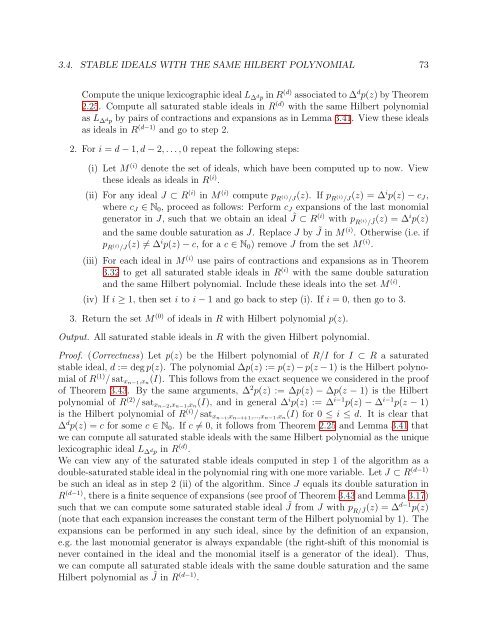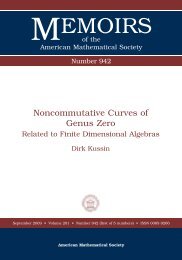University of Paderborn Department of Mathematics Diploma Thesis ...
University of Paderborn Department of Mathematics Diploma Thesis ...
University of Paderborn Department of Mathematics Diploma Thesis ...
You also want an ePaper? Increase the reach of your titles
YUMPU automatically turns print PDFs into web optimized ePapers that Google loves.
3.4. STABLE IDEALS WITH THE SAME HILBERT POLYNOMIAL 73Compute the unique lexicographic ideal L ∆ d p in R (d) associated to ∆ d p(z) by Theorem2.25. Compute all saturated stable ideals in R (d) with the same Hilbert polynomialas L ∆ d p by pairs <strong>of</strong> contractions and expansions as in Lemma 3.41. View these idealsas ideals in R (d−1) and go to step 2.2. For i = d − 1, d − 2, . . . , 0 repeat the following steps:(i) Let M (i) denote the set <strong>of</strong> ideals, which have been computed up to now. Viewthese ideals as ideals in R (i) .(ii) For any ideal J ⊂ R (i) in M (i) compute p R (i) /J(z). If p R (i) /J(z) = ∆ i p(z) − c J ,where c J ∈ N 0 , proceed as follows: Perform c J expansions <strong>of</strong> the last monomialgenerator in J, such that we obtain an ideal ˜J ⊂ R (i) with p R (i) / ˜J (z) = ∆i p(z)and the same double saturation as J. Replace J by ˜J in M (i) . Otherwise (i.e. ifp R (i) /J(z) ≠ ∆ i p(z) − c, for a c ∈ N 0 ) remove J from the set M (i) .(iii) For each ideal in M (i) use pairs <strong>of</strong> contractions and expansions as in Theorem3.32 to get all saturated stable ideals in R (i) with the same double saturationand the same Hilbert polynomial. Include these ideals into the set M (i) .(iv) If i ≥ 1, then set i to i − 1 and go back to step (i). If i = 0, then go to 3.3. Return the set M (0) <strong>of</strong> ideals in R with Hilbert polynomial p(z).Output. All saturated stable ideals in R with the given Hilbert polynomial.Pro<strong>of</strong>. (Correctness) Let p(z) be the Hilbert polynomial <strong>of</strong> R/I for I ⊂ R a saturatedstable ideal, d := deg p(z). The polynomial ∆p(z) := p(z) − p(z − 1) is the Hilbert polynomial<strong>of</strong> R (1) / sat xn−1 ,x n(I). This follows from the exact sequence we considered in the pro<strong>of</strong><strong>of</strong> Theorem 3.43. By the same arguments, ∆ 2 p(z) := ∆p(z) − ∆p(z − 1) is the Hilbertpolynomial <strong>of</strong> R (2) / sat xn−2 ,x n−1 ,x n(I), and in general ∆ i p(z) := ∆ i−1 p(z) − ∆ i−1 p(z − 1)is the Hilbert polynomial <strong>of</strong> R (i) / sat xn−i ,x n−i+1 ,...,x n−1 ,x n(I) for 0 ≤ i ≤ d. It is clear that∆ d p(z) = c for some c ∈ N 0 . If c ≠ 0, it follows from Theorem 2.25 and Lemma 3.41 thatwe can compute all saturated stable ideals with the same Hilbert polynomial as the uniquelexicographic ideal L ∆ d p in R (d) .We can view any <strong>of</strong> the saturated stable ideals computed in step 1 <strong>of</strong> the algorithm as adouble-saturated stable ideal in the polynomial ring with one more variable. Let J ⊂ R (d−1)be such an ideal as in step 2 (ii) <strong>of</strong> the algorithm. Since J equals its double saturation inR (d−1) , there is a finite sequence <strong>of</strong> expansions (see pro<strong>of</strong> <strong>of</strong> Theorem 3.43 and Lemma 3.17)such that we can compute some saturated stable ideal ˜J from J with pR/ ˜J(z) = ∆ d−1 p(z)(note that each expansion increases the constant term <strong>of</strong> the Hilbert polynomial by 1). Theexpansions can be performed in any such ideal, since by the definition <strong>of</strong> an expansion,e.g. the last monomial generator is always expandable (the right-shift <strong>of</strong> this monomial isnever contained in the ideal and the monomial itself is a generator <strong>of</strong> the ideal). Thus,we can compute all saturated stable ideals with the same double saturation and the sameHilbert polynomial as ˜J in R (d−1) .
















